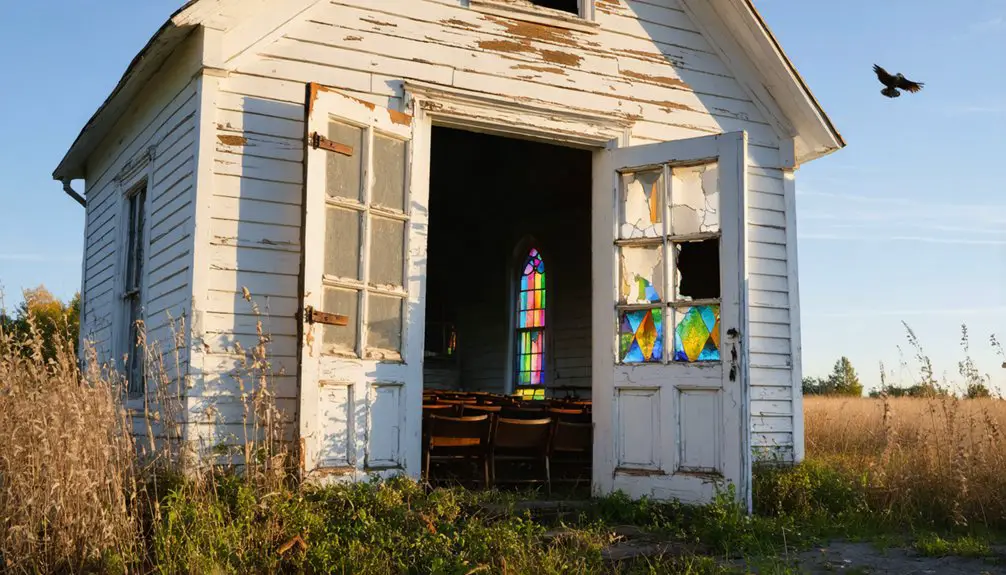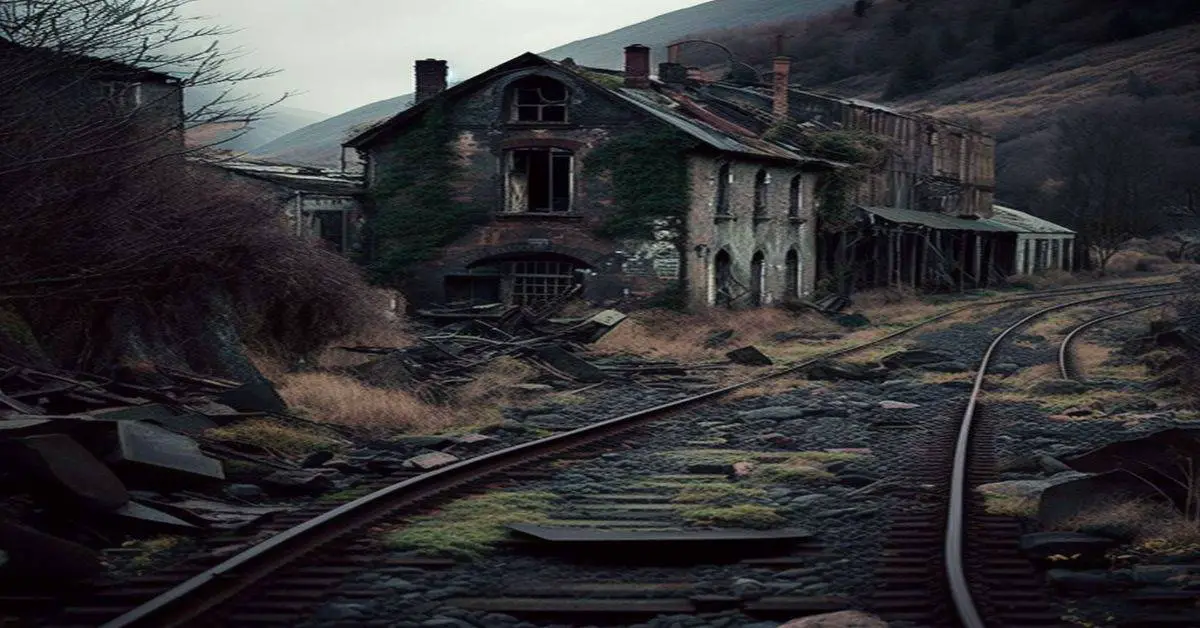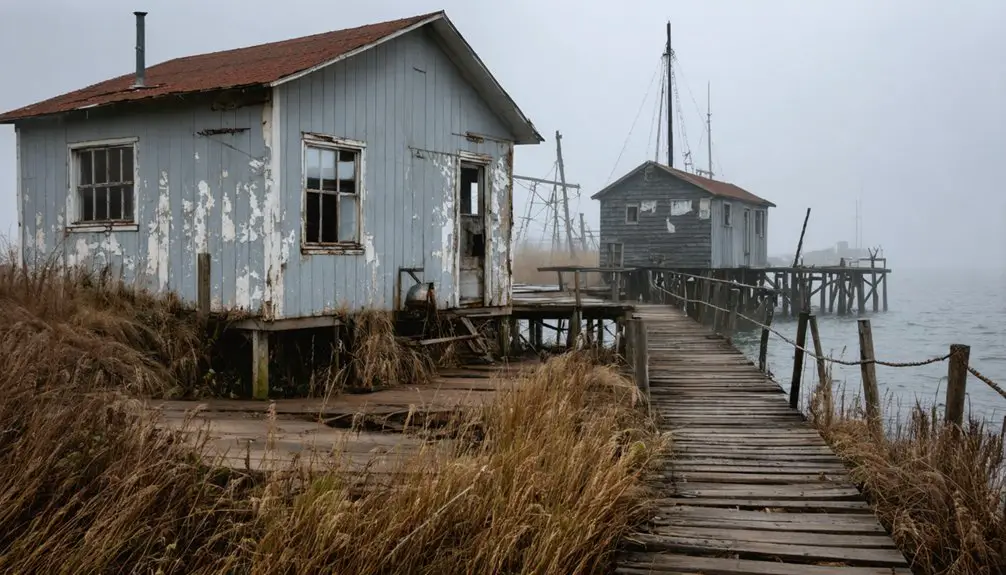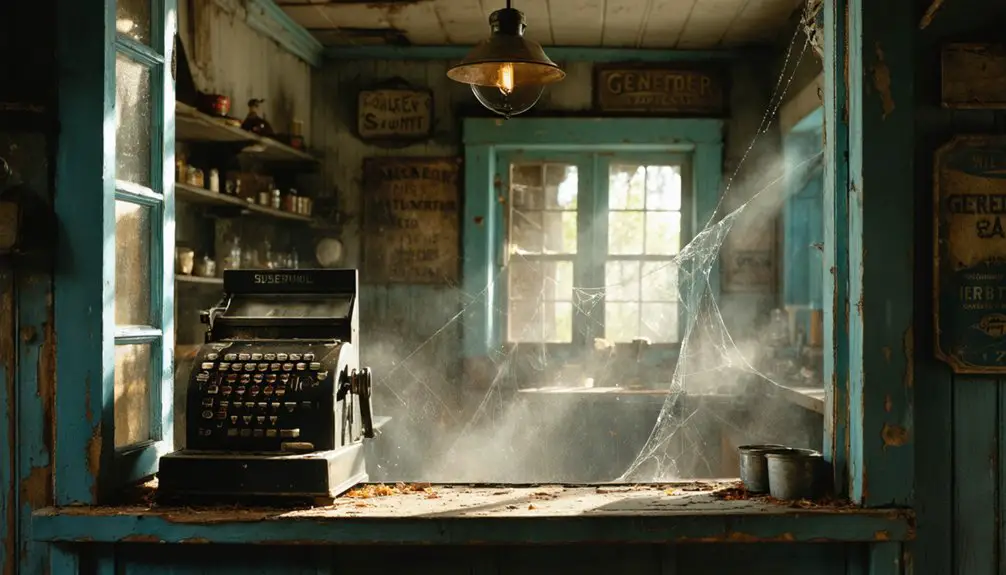You’ll discover Wisconsin’s haunting ghost towns scattered across the state, from Fort Howard’s abandoned military grounds to Pendarvis’s limestone mining cottages. Fort Crawford’s ghostly remains still echo with Zachary Taylor’s command, while Plainfield’s dark history draws paranormal enthusiasts. Dover vanished when the railroad passed it by, and Cooksville barely survived with its historic brick architecture. Places like Perote, Pikeville, and Pilot Knob hold untold stories within their empty streets and crumbling ruins.
Key Takeaways
- Plainfield’s dark history includes unexplained phenomena, mysterious fires, and the infamous Ed Gein murders that draw dark tourism visitors.
- Dover, established in 1844, vanished after being bypassed by railroads, leaving only scattered graves and haunting historical markers.
- Perote exemplifies rural town decline due to agricultural consolidation and lack of railroad access, becoming a ghostly reminder.
- The Pendarvis Mining Settlement features abandoned Cornish cottages from the 1830s, emptied by the California Gold Rush.
- Fort Howard’s remains include three historic structures, with its abandonment linked to disease outbreaks and military reassignments.
The Haunting History of Pendarvis Mining Settlement
When Cornish immigrants arrived in Mineral Point, Wisconsin during the 1830s and 1840s, they established the settlement of Pendarvis, bringing their mining expertise from Cornwall’s depleted tin mines to Wisconsin’s promising lead deposits.
You’ll find their legacy in the distinctive Cornish architecture – thick limestone walls and sturdy cottages like Pendarvis House, Trelawny, and Polperro that still stand today. These small limestone homes were built to resemble their traditional dwellings in England.
The settlement thrived until the California Gold Rush lured many miners away in 1849. Today, visitors can explore the area’s rich mining heritage through guided tours at the Pendarvis historic complex from May through October.
Fort Howard’s Abandoned Military Legacy
You’ll find Fort Howard’s strategic military presence along the Fox River in Green Bay, where it was established in 1816 to protect American settlements and secure essential waterways during western expansion.
The fort was vital in maintaining fur trade between settlers and Native American tribes throughout the region. In 1820, a devastating malaria outbreak forced troops to temporarily relocate to Camp Smith, though they’d return in 1822 before the fort’s final abandonment in 1841 during the Seminole Wars.
Today, you can explore the fort’s remaining structures at Heritage Hill State Historical Park, where three original buildings are listed on the National Register of Historic Places, including the relocated 1830s guardhouse that stands as a monument to this once-critical military outpost. Under the command of Zachary Taylor, the fort maintained its role as a crucial defensive position in the territory.
Strategic Military Positioning
Nestled along the west bank of the Fox River in Green Bay, Fort Howard emerged in 1816 as a critical military stronghold protecting America’s western frontier. The fort’s significance lay in its strategic control of the Fox-Wisconsin Waterway, an essential trade route connecting Lake Michigan to the Mississippi River.
You’ll find it was the first major U.S. military presence west of Lake Michigan, establishing a foothold for westward expansion. Major Zachary Taylor commanded the fort from 1817 to 1820, fostering positive relations with French settlers through his welcoming hospitality.
As part of a larger military strategy, Fort Howard linked eastern strongholds like Fort Niagara and Fort Detroit with frontier outposts including Fort Winnebago and Fort Crawford. This network secured interior trade routes and projected American power into newly acquired territories.
The fort’s position enabled troops to monitor both water and land routes, effectively safeguarding American interests against British and Native American forces. A military road constructed in 1872 further strengthened the fort’s connections to other defensive positions in the region.
Disease Ends Fort Occupation
Despite Fort Howard’s strategic military importance, its fate would be shaped by an unexpected enemy: disease. You’ll find that in 1820, a severe malaria outbreak forced the garrison to temporarily abandon the fort, retreating to higher ground at Camp Smith. This disease outbreak greatly disrupted military operations, revealing the harsh realities of frontier fort life.
Though troops returned in 1822 after the epidemic subsided, health challenges continued to plague the installation. The military disruption caused by diseases like malaria would ultimately contribute to Fort Howard’s decline. The fort served as a crucial military outpost protecting the Fox River waterway until its final decommission in 1853. Today, the site features three historic structures that are listed on the National Register of Historic Places.
Modern Historical Site Remnants
While most of Fort Howard’s original structures have vanished over time, several significant remnants preserve its military legacy at Heritage Hill State Historical Park.
You’ll find the Federal-style Guard House, relocated in 2010, standing as a tribute to the fort’s 19th-century military presence. The hospital, hospital ward, and officers’ quarters have earned spots on the National Register of Historic Places, offering glimpses into frontier military life. Located on the western Fox River, Fort Howard played a vital role in defending newly acquired territories.
Though ghostly encounters aren’t documented, the historical preservation efforts at Heritage Hill keep Fort Howard’s story alive through reconstructed buildings and authentic structures from the original military post.
The park serves as a living museum where you can explore the strategic outpost that once protected the essential Fox-Wisconsin Waterway and helped secure America’s expansion westward. Disease outbreaks led to temporary relocations, including when the garrison moved to Camp Smith in 1820 due to malaria.
Fort Crawford: From Presidential Command to Ghostly Grounds
You’ll find the ghostly remains of Fort Crawford in Prairie du Chien, where future U.S. President Zachary Taylor commanded from 1829 to 1837 and oversaw construction of the limestone fortress.
What was once a strategic military outpost controlling crucial river routes now lies mostly buried beneath modern developments, including a municipal swimming pool built over part of the original foundation.
The site’s rich military heritage, which included hosting future Confederate President Jefferson Davis during his time as a lieutenant, echoes through the scattered limestone ruins and preserved museum spaces that stand as silent witnesses to Wisconsin’s territorial past.
Military Heritage and Legacy
As one of Wisconsin’s most significant military outposts, Fort Crawford left an indelible mark on American military history from 1816 to 1864.
You’ll find its ghostly remains at the strategic confluence of the Mississippi and Wisconsin Rivers, where it once stood as a symbol of American expansion and military might.
The fort’s legacy includes three remarkable distinctions:
- Site of the historic 1825 Treaty of Prairie du Chien, gathering nearly a dozen Native American tribes
- Command post of future President Zachary Taylor during the Black Hawk War
- Transformation from frontier fortification to essential Civil War training ground and hospital
What began as a wooden fortress evolved into a complex military installation, and today you can explore its haunting grounds while experiencing the echoes of soldiers who shaped America’s territorial growth.
Taylor’s Command Post
When Lieutenant Colonel Zachary Taylor took command of Fort Crawford in July 1829, he inherited a strategic outpost that would shape both his military career and America’s westward expansion.
You’ll find his military legacy embedded in the fort’s limestone walls, which he ordered built to replace the original wooden structures. Under Taylor’s command, the garrison grew to over 170 men, equipped with twelve-pounders and an arsenal that could defend against any threat.
Though Taylor’s command was interrupted by furloughs and the Seminole uprising, his most significant moment came when Chief Black Hawk surrendered to him after the Battle of Bad Axe.
Today, you can walk the grounds where Taylor, future Confederate President Jefferson Davis, and pioneering surgeon William Beaumont once shaped American history.
Modern Pool Site Transformation
Despite its storied military past, Fort Crawford‘s grounds now serve a dramatically different purpose, transformed from a limestone fortress into a vibrant community pool complex.
You’ll find this remarkable evolution represents the community’s commitment to historic preservation while meeting modern recreational needs.
When you visit today, you’ll discover three key transformations:
- The military grounds have been repurposed into public leisure spaces
- The pool complex serves as a central gathering point for community engagement
- The site balances heritage awareness with contemporary amenities
Rather than letting the fort deteriorate into an abandoned relic, Prairie du Chien’s residents have breathed new life into this historic space.
The pool site stands as a representation of adaptive reuse, proving that even the most formidable military installations can evolve to serve peaceful, recreational purposes.
Plainfield’s Dark Past and Mysterious Decline
The Plainfield mysteries extend beyond Gein’s confirmed murders and grave robberies. His farmhouse mysteriously burned down, and locals report strange phenomena near his former property.
Earlier tragedies from the 1850s, including Cartwright’s near-lynching, had already cast a shadow over the settlement.
Today, you’ll discover a community that draws dark tourism despite its troubled past, with ghost tours exploring both the validated horrors and persistent legends that continue to haunt this rural hamlet.
Dover: A Town Lost to Time
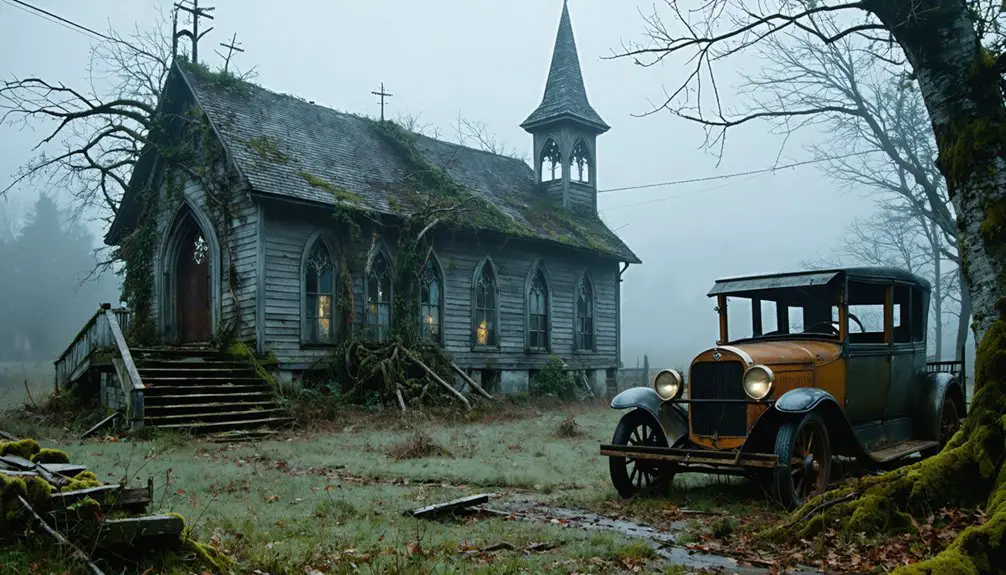
Once a symbol of British immigrant ambition in Wisconsin Territory, Dover emerged in 1844 through the efforts of the British Temperance Emigration Society.
You’ll find that Dover’s disappearance began when the Milwaukee Road railroad bypassed the settlement, choosing Mazomanie instead. By 1870, this once-thriving community of 700 settlers had completely vanished.
Today, Dover’s legacy lives on through:
- Scattered graves and historical markers that dot the former townsite
- Ghostly legends and paranormal tales that attract ghost hunters
- Wisconsin state historical documentation preserving its story
While urban legends often confuse Dover with the mythical “Doveland,” you’re exploring a real piece of Wisconsin history – a reflection of how quickly frontier dreams can fade when crucial transportation links bypass a settlement.
The Empty Streets of Cooksville
While Dover vanished into Wisconsin’s historical mist, another ghost town tells a different tale of survival.
You’ll find Cooksville’s empty streets lined with pristine brick buildings that have defied time since 1842. When the railroad bypassed this small village in 1857, it could have disappeared like countless others. Instead, the town’s superior brick architecture became its salvation.
When time and railroads left Cooksville behind, its masterful brick architecture refused to crumble, preserving a village frozen in 1842.
You can still walk through what’s known as “the village time forgot,” where over 35 historic structures stand as evidence to early ghost town preservation efforts.
The Greek and Gothic Revival buildings, complemented by the original town square, showcase a rare slice of transplanted New England. Since 1999, the Historic Cooksville Trust has maintained this architectural legacy, ensuring these quiet streets continue telling their unique story.
Perote and Menominee: Tales of Two Forgotten Communities
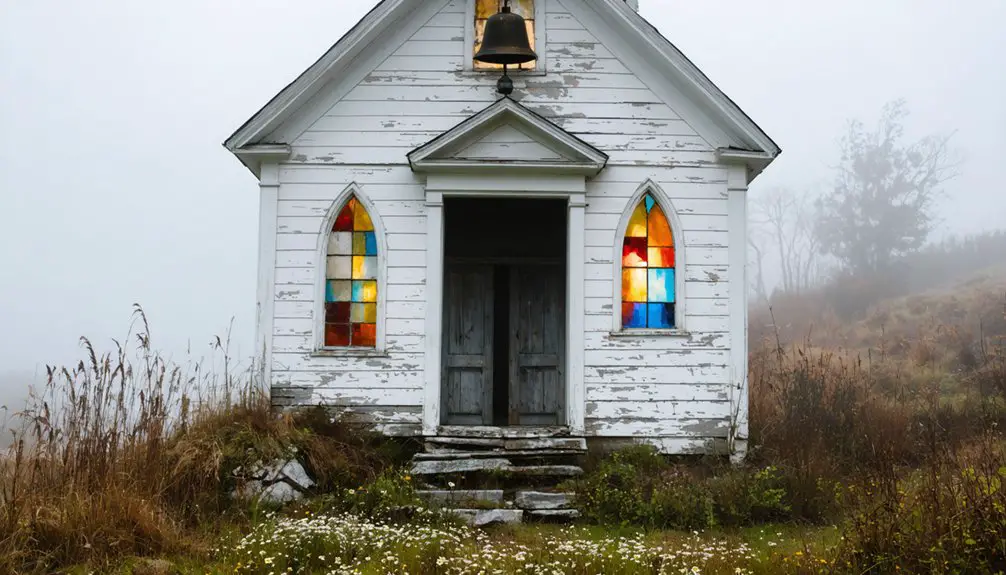
Deep in Menominee County, Perote stands as a poignant reminder of Wisconsin’s vanishing rural communities. Located just 5 miles from White Lake, this forgotten settlement tells a story of Perote’s decline that mirrors countless other rural towns across the state.
You’ll find a place where agricultural consolidation and shifting populations gradually emptied the streets, leaving only traces on USGS maps as late as 1952.
The rich Menominee heritage of the surrounding county adds depth to Perote’s quiet disappearance:
- Small farming communities once dotted the landscape, supporting local businesses.
- The absence of railroads and major transportation routes hastened the town’s fade into obscurity.
- Unlike mining ghost towns, Perote’s transformation came through the slow dissolution of rural life.
The town now exists as a reflection of Wisconsin’s changing agricultural landscape.
Pikeville’s Industrial Decay
Scattered ruins of sawmills and factories mark Pikeville’s stark transformation from a bustling industrial center to Wisconsin’s most haunting example of post-industrial decay.
As you explore the town, you’ll find rusting machinery, broken windows, and collapsing warehouses – silent witnesses to the economic stagnation that followed the rerouting of crucial rail lines in the mid-20th century.
You can trace the industrial decline through overgrown lots where factories once hummed with activity.
The aging population and shuttered businesses tell a story of mass exodus, while contaminated soil and crumbling infrastructure limit hopes for renewal.
Empty storefronts and toxic earth haunt Pikeville’s streets, leaving its elderly residents as caretakers of a dying industrial dream.
What’s left is a photographer’s paradise of nature reclaiming abandoned industrial sites, though the unstable structures and chemical residues demand caution.
Pikeville now stands as a sobering reflection of the fleeting nature of industrial prosperity.
Pilot Knob: A Resource-Depleted Ghost Town
Before becoming a ghost town, Pilot Knob held profound significance as Oȟéyawahe, a sacred burial site for Sioux Indians and other Native American groups spanning two centuries.
The rich cultural heritage of this area is woven into ghost town folklore, where stories like Scarlet-Dove’s mourning reflect deep spiritual connections to the land.
You’ll find this once-thriving settlement’s decline marked by three key factors:
- Agricultural consolidation that drove out small farms
- Loss of essential infrastructure, including the post office established around 1850
- Economic erosion that forced businesses like gas stations and motels to close
The area’s transformation from a bustling stagecoach stop to an abandoned settlement serves as a reflection of how changing land use patterns and resource depletion can reshape communities.
Frequently Asked Questions
Are There Documented Paranormal Activities in Wisconsin’s Ghost Towns?
You’ll find extensive paranormal investigations documenting shadowy figures, EVPs, and cold spots across Wisconsin’s abandoned towns, while local legends of tragic deaths and mysterious events enhance these supernatural claims.
Can Visitors Stay Overnight in Any of These Abandoned Towns?
While you can’t camp in abandoned towns due to safety regulations, you’ll find overnight accommodations in nearby historic haunted hotels like Brumder Mansion or Old Rittenhouse Inn for paranormal experiences.
What Items Have Treasure Hunters Discovered in These Ghost Towns?
You’ll find treasure hunting yields Civil War coins, gold nuggets, mining tools, copper buttons, household items, and historical artifacts like ceramics near old trade routes and abandoned settlements throughout Wisconsin.
Do Any Descendants of Original Residents Still Maintain These Properties?
Despite what your Instagram feed suggests, you won’t find many descendants maintaining original residents’ properties in Wisconsin ghost towns. Historical societies and local governments typically handle preservation of surviving structures instead.
Which Ghost Towns Are Completely Off-Limits to the Public?
You’ll find strict legal restrictions block access to several former mining settlements on the Keweenaw Peninsula and privately-owned historic trading posts, despite their significant historical value to Wisconsin’s past.
References
- https://upnorthnewswi.com/2024/02/21/the-fascinating-stories-behind-7-wisconsin-ghost-towns/
- https://www.onlyinyourstate.com/experiences/wisconsin/ghost-towns-wi
- https://en.wikipedia.org/wiki/List_of_ghost_towns_in_Wisconsin
- https://kids.kiddle.co/List_of_ghost_towns_in_Wisconsin
- http://shunpikingtoheaven.blogspot.com/2016/05/a-wisconsin-ghost-town.html
- https://www.southwestwi.com/pendarvis/
- https://en.wikipedia.org/wiki/Pendarvis_(Mineral_Point
- https://trailsandtravel.com/pendarvis/
- https://www.portalwisconsin.org/archives/pendarvis_feature.cfm
- https://pendarvis.wisconsinhistory.org/explore/history-of-pendarvis/
